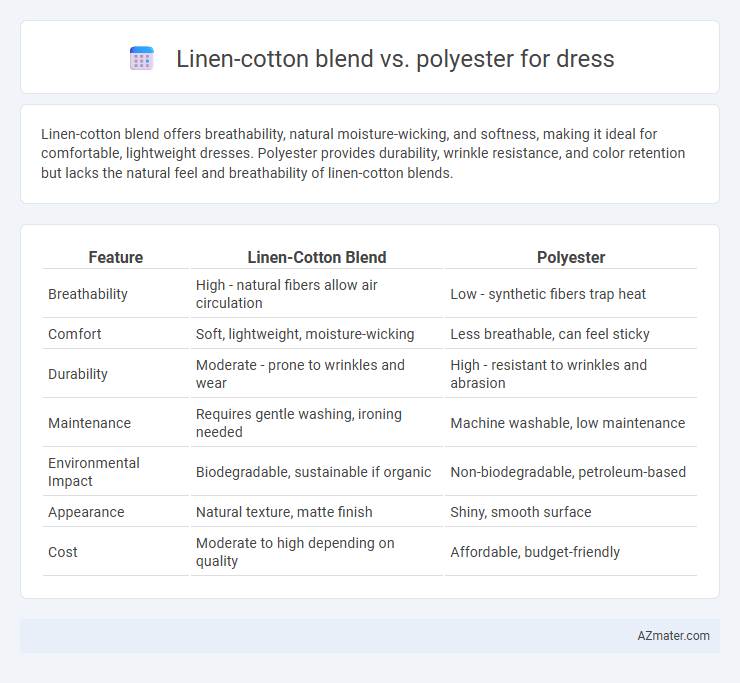Linen-cotton blend offers breathability, natural moisture-wicking, and softness, making it ideal for comfortable, lightweight dresses. Polyester provides durability, wrinkle resistance, and color retention but lacks the natural feel and breathability of linen-cotton blends.
Table of Comparison
| Feature | Linen-Cotton Blend | Polyester |
|---|---|---|
| Breathability | High - natural fibers allow air circulation | Low - synthetic fibers trap heat |
| Comfort | Soft, lightweight, moisture-wicking | Less breathable, can feel sticky |
| Durability | Moderate - prone to wrinkles and wear | High - resistant to wrinkles and abrasion |
| Maintenance | Requires gentle washing, ironing needed | Machine washable, low maintenance |
| Environmental Impact | Biodegradable, sustainable if organic | Non-biodegradable, petroleum-based |
| Appearance | Natural texture, matte finish | Shiny, smooth surface |
| Cost | Moderate to high depending on quality | Affordable, budget-friendly |
Introduction to Linen-Cotton Blend and Polyester Fabrics
Linen-cotton blend fabric combines the natural breathability and moisture-wicking properties of linen with the softness and durability of cotton, making it ideal for comfortable and stylish dresses. Polyester fabric, a synthetic material, is known for its wrinkle resistance, strength, and quick-drying capabilities, offering easy maintenance and longevity. The choice between linen-cotton blend and polyester for dresses depends on desired comfort, texture, and care preferences.
Fabric Composition: Linen-Cotton Blend vs Polyester
Linen-cotton blend fabric combines the natural breathability and moisture-wicking properties of linen with the softness and durability of cotton, creating a lightweight and comfortable material ideal for dresses in warm climates. Polyester, a synthetic fiber derived from petrochemicals, offers high durability, wrinkle resistance, and moisture-wicking capabilities but lacks the natural breathability found in linen-cotton blends. The fabric composition difference significantly impacts dress performance, with linen-cotton blends favoring comfort and eco-friendliness, while polyester emphasizes longevity and easy care.
Comfort and Breathability Comparison
Linen-cotton blends offer superior breathability and moisture-wicking properties, making them ideal for warm weather dresses by keeping the skin cool and dry. Polyester, while durable and wrinkle-resistant, tends to trap heat and moisture, reducing overall comfort in hot conditions. The natural fibers in linen-cotton blends enhance airflow and softness, providing a more comfortable wearing experience compared to the synthetic feel of polyester.
Durability and Longevity
Linen-cotton blend dresses offer moderate durability due to the natural fibers' combined strength, providing breathability and comfort but slightly less resistance to wear compared to synthetic fabrics. Polyester dresses excel in durability and longevity, resisting wrinkles, stretching, and shrinking while maintaining color vibrancy over extended use. Choosing polyester enhances dress lifespan in high-activity or frequent-wear scenarios, whereas linen-cotton blends favor natural fiber benefits with moderate endurance.
Maintenance and Care Requirements
Linen-cotton blends require gentle washing in cold water and should be air-dried to prevent shrinking and maintain fabric integrity, whereas polyester is machine washable and dries quickly without special care. Linen-cotton fabrics may need ironing to address wrinkles, while polyester is more wrinkle-resistant and often wrinkle-free. Stain removal is easier with polyester due to its synthetic fiber properties, whereas natural fiber blends might need more delicate treatment.
Environmental Impact and Sustainability
Linen-cotton blends offer significantly lower environmental impact compared to polyester, as both linen and cotton are biodegradable natural fibers with renewable sources. Polyester, derived from petrochemicals, contributes to microplastic pollution and consumes more energy and water during production. Choosing linen-cotton blend dresses supports sustainable fashion by reducing carbon footprint and promoting eco-friendly textile waste management.
Cost and Value for Money
Linen-cotton blend dresses typically cost more upfront due to the natural fibers and breathability, offering superior comfort and durability that enhance long-term value. Polyester dresses are generally less expensive, providing excellent stain resistance and wrinkle-free properties, making them budget-friendly but less breathable. Evaluating cost and value for money depends on prioritizing initial affordability versus the comfort and lifespan associated with linen-cotton blends.
Style and Versatility for Dresses
Linen-cotton blend dresses offer a natural texture and breathable comfort, enhancing a casual yet polished style ideal for warm weather. Polyester dresses provide durability and wrinkle resistance, maintaining vibrant colors and structured silhouettes suitable for formal or everyday wear. Choosing between these fabrics depends on the desired balance of effortless elegance and low-maintenance versatility in a dress wardrobe.
Wrinkle Resistance and Appearance
Linen-cotton blends offer a natural, breathable fabric with moderate wrinkle resistance, yet they tend to crease more easily than polyester, which is known for its superior wrinkle resistance and smooth appearance. Polyester maintains a crisp, polished look throughout the day, making it ideal for low-maintenance dresses that require minimal ironing. Dresses made from linen-cotton blends exhibit a more textured, casual aesthetic but require careful care to preserve their shape and reduce creasing.
Best Occasions and Recommendations
Linen-cotton blend dresses excel in warm-weather events like garden parties, summer weddings, and casual outings due to their breathability and natural texture. Polyester dresses are ideal for formal occasions, evening events, and travel wear because of their durability, wrinkle resistance, and moisture-wicking properties. For best results, choose linen-cotton blends for comfort and natural elegance in relaxed settings, while polyester offers practicality and a polished look for structured or long-lasting wear.

Infographic: Linen-cotton blend vs Polyester for Dress
 azmater.com
azmater.com